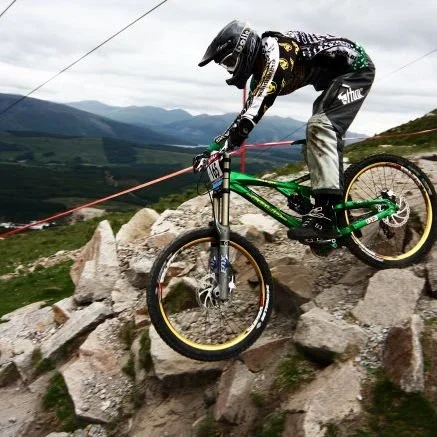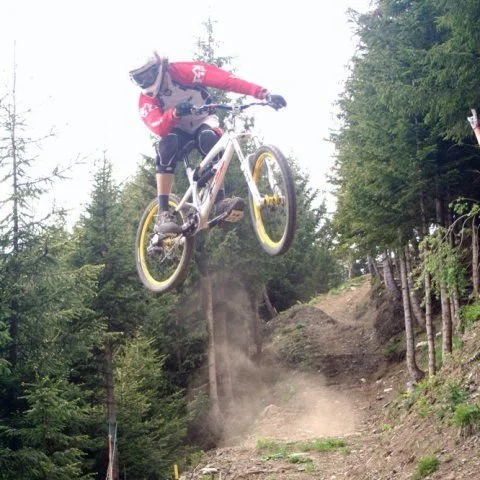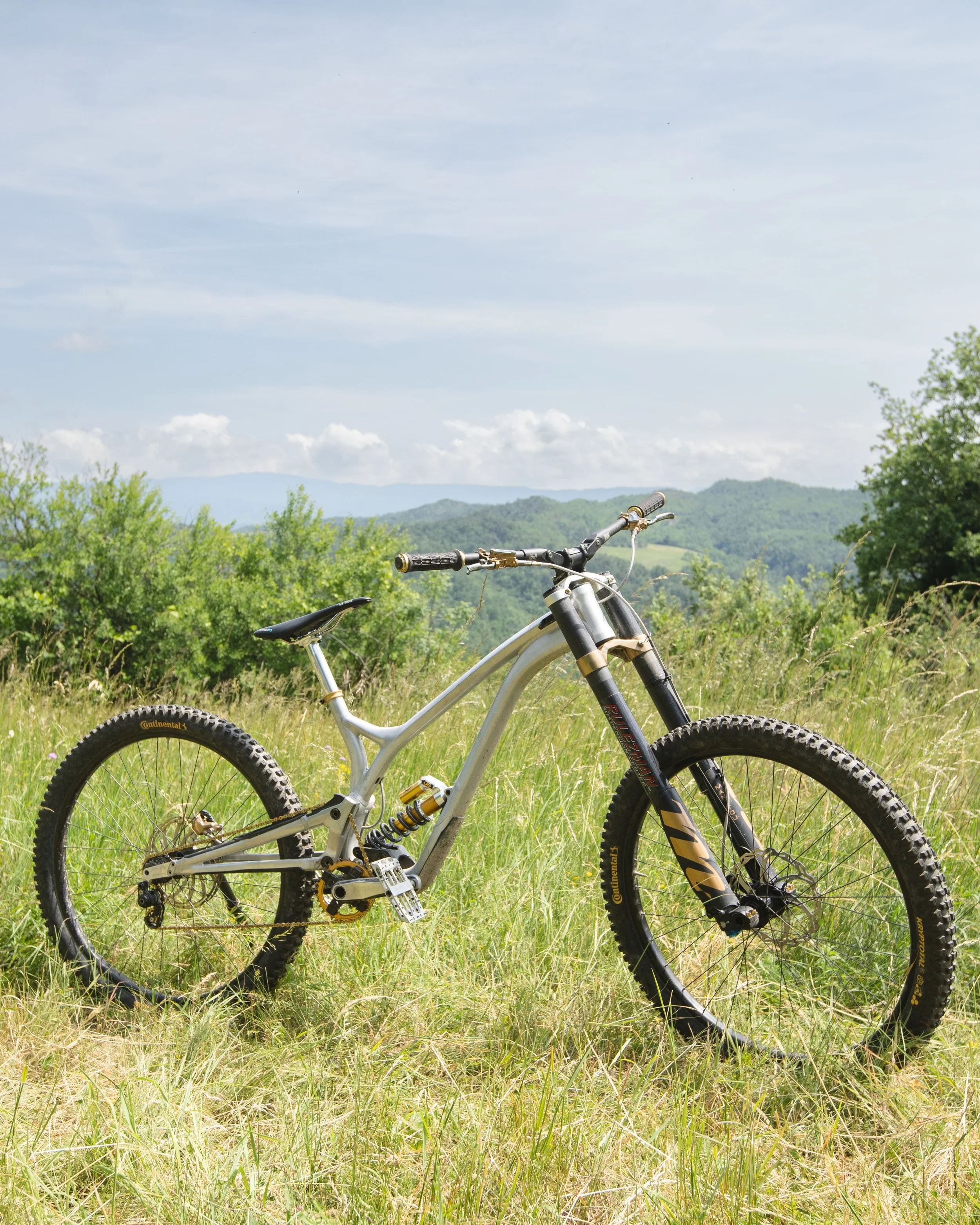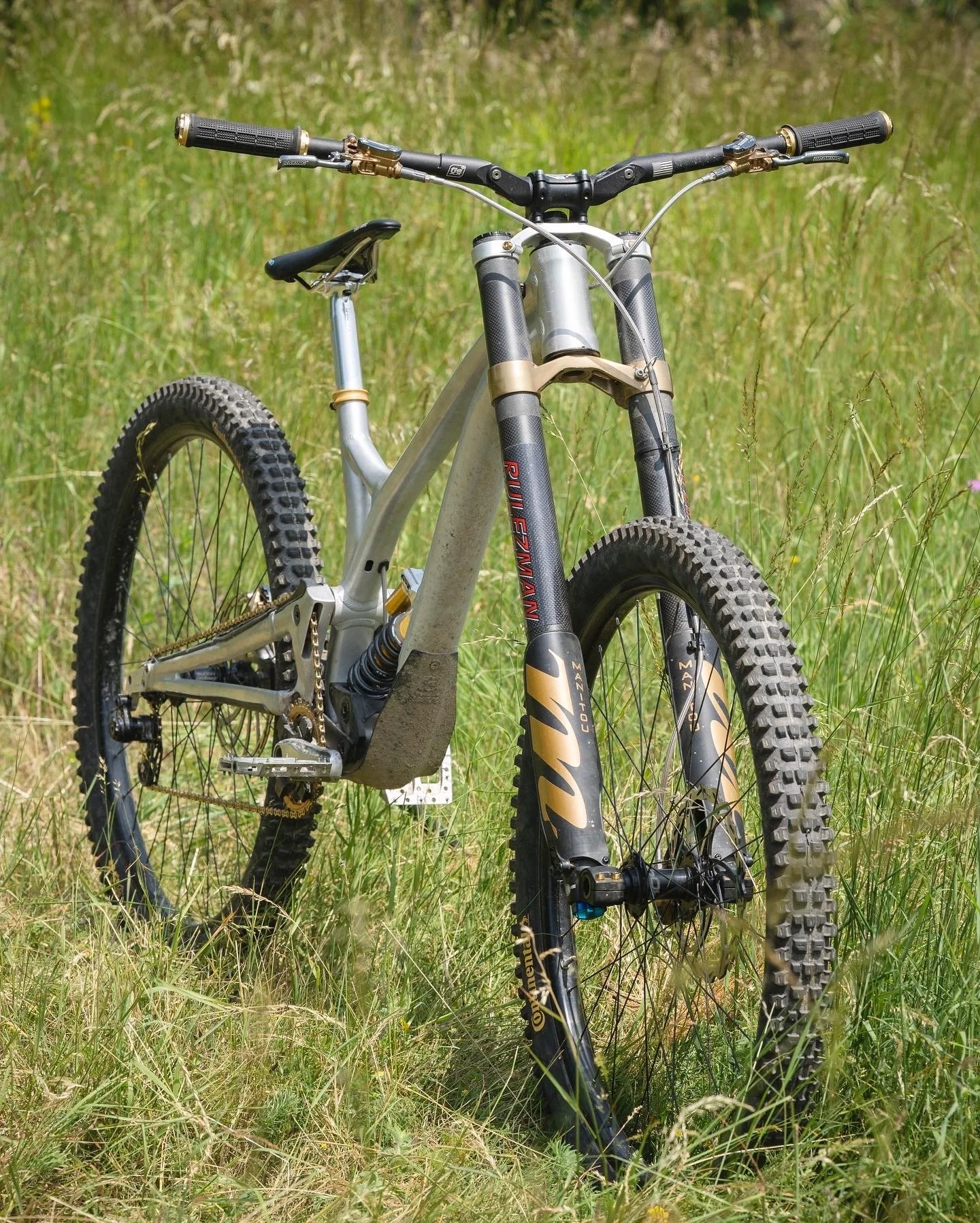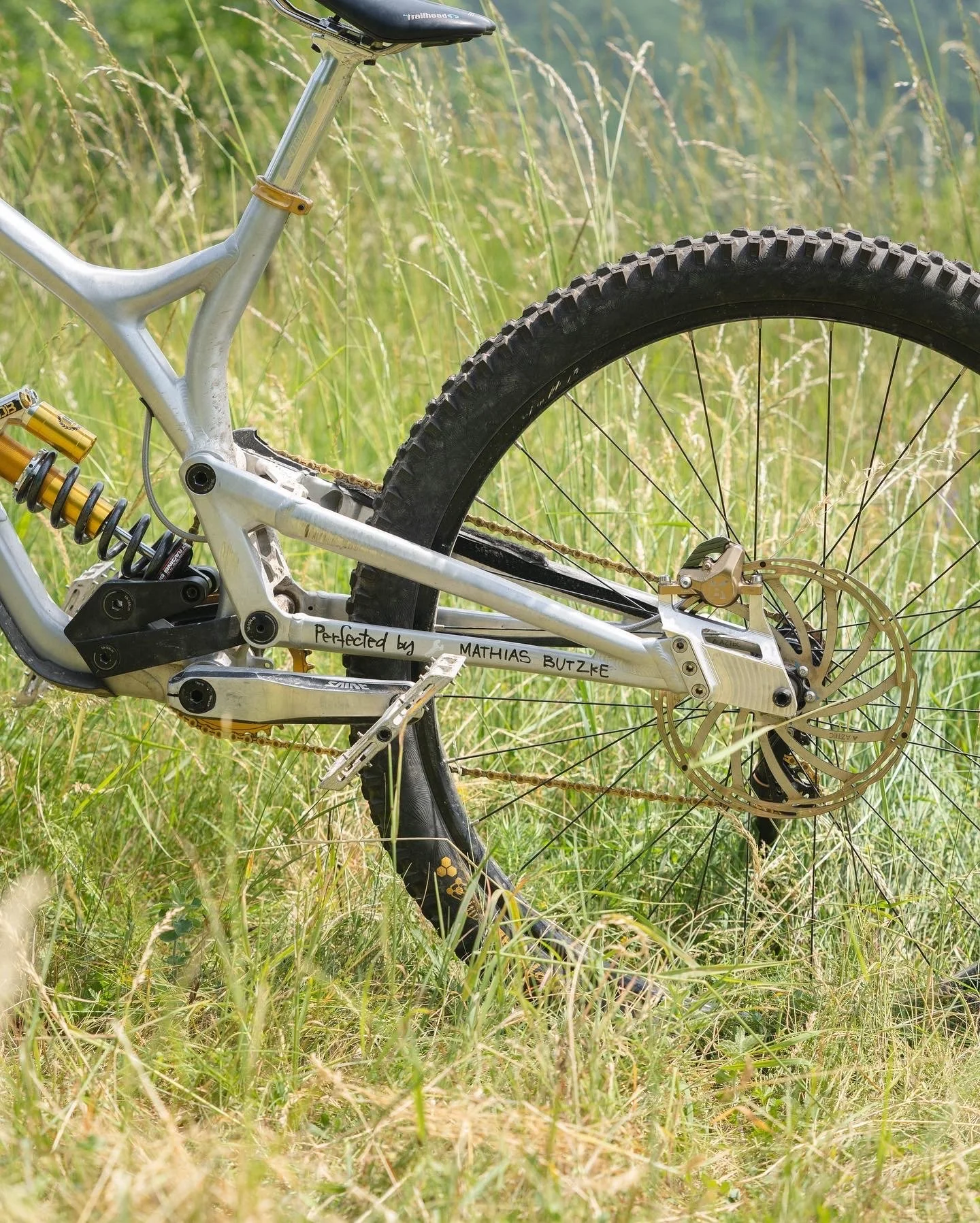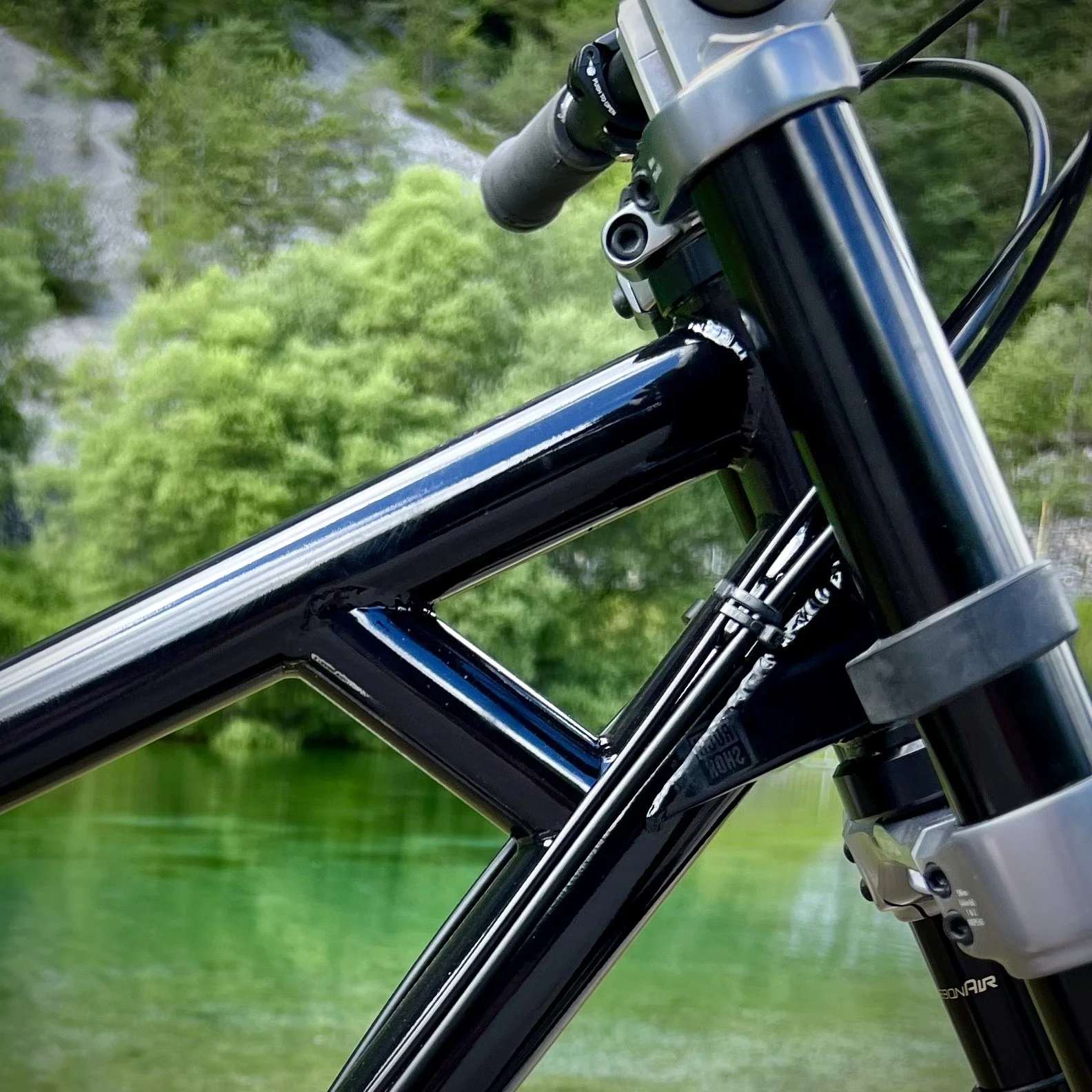Egerie Aston-A-Tron - PT2 Geometry
Geometry: A Long Story
Geometry and sizing are the most important aspects of any bike. Get this wrong, and nothing else really matters: you will be fighting an uphill battle to feel comfortable and then ride fast. My first real revelations with geometry started with the original GeoMetron I tested for Pinkbike way back in 2015.
Before this, we had all been riding tiny bikes. Just look back at any DH footage from a decade or so ago compared to nowadays, and everybody looks like giants riding kids' bikes, compared to riders who look balanced and well-placed in the middle of a modern machine.
Above: 2008 on a Solid Mission 9 , I think this had a 420mm reach. Then in 2021 with a 510mm reach.
I’d been on a mission for years to get bigger bikes and always felt better on them. On shorter bikes, my riding days were much more hit-and-miss, somedays I felt great and on others, I couldn’t put it together. I would crash a lot and still carry multiple OTB-related injuries. A quote to remember for later from Chris Porter: “Rossi doesn’t have bad days, if he is, the engineers find the problem and he’s straight back on it”
I’m 185cm / 6’ and I believe bikes used to be ok for smaller riders, but the M-XL side of the spectrum were missing out. This came as an evolution from road bike sizing where long stems and layback posts added extra length for bigger frame sizes.
Back in the day, guinea-pigging new jumps at Champery to check they were suitable before World Champs - this was the first bike where I really cracked the code.
The first decent-sized machine I had was an MSC F5 in 2009, with a reach of around 450mm and a 60mm Truvativ Direct Mount stem. This bike had a matching 450mm swingarm, and with a lot of tuning help from Nigel Reeve, aka NSR Racing, this was the first bike I owned which I felt was well-balanced and easy to ride. Over the years, the next bikes that didn’t kill my lower back within the first 30 seconds of a run were the 2013 Specialized Enduro with 465mm reach (60mm stem), then a Mondraker Foxy with a 501mm reach (30mm stem), which I spent a couple of great days on in Madeira.
Not long after, I got to ride the Mojo Geometron with a 520mm reach and an actual HA of 62ish on the trail. This was it: comfort at last in all scenarios. It was superbly easy to descend with the front axle so far away; the super steep seat angle and long chainstay made climbing a doddle. It cornered like nothing else. I praised this bike for ages, and then followed the Pole EvoLink, which was a very close GeoMetron copy. I took loads of flak across the internet, well the PB comment section, with people saying I had no idea what I was talking about. Fast forward nine years, and the majority of bikes are pretty close to that bike from 2015.
But I knew there was more. How could we just keep making the front longer and forget the rear? How could I ride through gnarly rock gardens and deep ruts without being terrified of clipping a pedal and crashing? Why did it still feel better climbing with the saddle slammed all the way forward on the rails? Why did the Mondraker Level eMTB with a 490mm chainstay go around tight switchbacks in Finale better than anything I had ever ridden? Why did Sam Hill in his glory days ride a bike with a 450mm reach and chainstay?
Above: custom dropouts for the Supreme project, including the penis that broke Cindy’s back (thats the name of BTR’s CNC machine).
A few more years on, with my own business and more freedom to experiment, I bought a used frame to build the Commencal “Supreme Supreme” as I loved testing that bike for PB. I had also kept looking at the replaceable dropouts and pull linkage and thought there was some room for manoeuvre. A phone call to the legend at Redburn, Alistair Beckett, and we had some new dropouts designed with a matching linkage. Another legend, Paul Burford from BTR, machined one of them and broke his CNC machine etching a cartoon penis into it. The third legend, Mathias Reichmann from EMRG, finished the job.
These new dropouts and links transformed that bike from a 455mm chainstay, with 29” wheels and massive progression and some BB drop, to a mixed wheel machine, a 495mm chainstay, 0mm BB drop, and a much more linear feel.
Within the first couple of corners at the local bike park, I knew I was onto something. The balance between the wheels I had been inching towards for years was suddenly a mile closer. Staying in the centre of the bike was extremely easy in high-G berms and compressions. My feet and pedals also seemed to have more clearance than ever, and I wasn’t scared of ploughing past chunky rocks and through ruts. But it still leaned into corners beautifully and had massive stability.
Long story, right? Now I’ll talk about this bike.
I’ve had four frames made by Egerie now, all with near-identical geometry. Literally 10mm difference at most. More than a decade later, this black beauty from the Haute Savoie finally does everything I’d been looking for for years.
Seat Angle
The 80º seat angle makes climbing exceptionally easy with an upright body position that allows more power from the glutes to be used: reducing hip tightness and lower back soreness. Why do the UCI road bike and time trial rules prevent riders from having their saddle too far forward? Power advantage?
Geometry Numbers: Reach 510mm|Stack 642mm|CS 490mm|HA 63°|STA 80°|HT 120mm|BB +10mm
Chainstay
Combine this seat angle with a long chainstay acting like a wheelie bar on a dragster, and front wheel wander and lift are non-existent even with the extremely DH-focused setup of this bike: Focus the setup on climbing and it would be awesome.
But you can’t corner with a long chainstay, right? Despite hearing this for years, I think this was wrong, wrong, wrong. I find the longer chainstay makes it easier to turn even in tight corners. Why? Being in a more central position means more weight on the front wheel and less on the rear, so in tight corners, it is easier to get the rear wheel to break traction and start to nicely oversteer like a rally car in a hairpin, either by turning hard with your hips or feathering the rear brake. On longer, faster turns, it just cruises around without issue.
”You can’t manual it though” True, manualling is tougher to get the front wheel up, but it’s actually more stable when it’s going. I can easily pop the front wheel of this bike enough to get over any trail obstacles and for low-speed drops. Any more than that is doing a trick, which my BMX does beautifully at the skate park. If you want to do that on an MTB on a trail, that’s cool, but it’s not performance-related.
Head Angle
The slack head angle is the obvious one: easier to descend, less chance of going over the front, and makes the bike turn more when leaned over—how 99% of turns should be done. This also makes endo turns for the other 1% easier than with a steeper head angle, as you can be more confident and aggressive with the manoeuvre.
I went a tiny bit steeper on this bike than the others to try it but ended up using a -0.5º angleset as I prefer sub-63, especially with the awesome Avalanche fork which runs a lot of sag. Those OTB injuries from my younger years? I hope to god the day doesn’t come when I go out the front door on one of these bikes as that will be a huge accident: with the big front wheel and short stem making it even more difficult to pitch over the front - I’ve never been close.
BB height
Making the bottom bracket lower helped stability on old bikes that had smaller wheels, tiny reach and steep head angles. Things have evolved a lot since then, but many brands tried to keep the BB the same height from the ground that felt good a decade ago. Modern bigger wheels raise the axles from the ground, slacker head angles make the bike more stable plus a longer reach means a longer overall wheelbase.
Now the bikes have plenty of stability so the BB can be higher without issue making pedal strikes nearly non-existent, even with the 180mm cranks on my Pinion bike. Also, the BB needs to be higher for clearance as the bikes are longer: think of a long vehicle going over a low-speed bump. Also to note, this bike is running 200mm of travel with 33% sag, so it’s not like the BB is sky high, some recently launched bikes like the Commencal Supreme V5, for example, have a height or +3/-3mm depending on the flip chip position.
I have also found that the higher BB makes consecutive cornering easier when unweighting the bike correctly: load the bike into the corner for grip, unweight as you exit, and change direction. When the bike is high in the travel as you are unweighted, it’s much easier to tilt the bike over into the next corner.
I also find it easier to brake harder on the front brake because your mass is higher and pushes the front wheel down into the ground more: if you are lower between the axles your weight is trying to push the tyre’s contact patch in a more forward direction.
Reach
I don’t believe it’s big at all and it is made to feel shorter with the Rulezman 18mm stem. I’m fairly tall but not a giant, so I think there are people out there who could need a much bigger size than this.
The bikes simply started off being too small and now the longer size scares people. I know MTB’s are different to MX bikes but here are some interesting numbers. Measuring from the peg-centre/BB-centre to the outside centre of the handlebar on some different bikes: my Surron which is regarded as a teenagers midi-MX bike is 920mm. My KTM Freeride which is one size fits all is 930mm. This black beauty which has the longest wheelbase of nearly any MTB in the world is 935mm.
If we started the evolution of MTB’s from true MX bikes instead of road bikes, we’d have been in this position decades ago and it would all seem normal.
Any downsides
Nothing major that I can find. Of course, I’m a fairly tall rider and I’m not saying this is for everyone, the geometry should be scaled for sizes. As mentioned, full manuals are tough to initiate, but not needed. The higher BB makes the stack lower, so I have struggled to get the bar as high as I want without it looking uglier than Stackota Norton’s setups. I’ve seen a few comments online from people saying I am biased for some personal gains, those people should ask why I’ve bought four bikes with the same geo with my own money?
MX bikes have basically had the same geometry for decades, and the focus is on tuning and setting the bike to be neutral and balanced. This is the point I feel I have finally gotten to with this bike: there’s no possible way I think the geo could be improved, and I would use the same geo for anything, including an XC race bike. The fine-tuning of the sag percentages, bar height, and seat position would be slightly different, but the general chassis shape wouldn’t change.
Great free article! But, how do I win it and support AstonMTB?
To win this bike all you need to do is head to my Raffall page, answer a simple question and you have an extremely good chance to win: current odds at the time of publishing this article are 1/227 for only £6!
Global shipping is also included so entrants are invited from anywhere in the world.
The giveaway is guaranteed to happen on the end date regardless of how many tickets are sold. No extensions, no minimum ticket sales.
These competitions fund my reviews which I believe are the only truly independent MTB reviews online. All of the prizes and all of the products you see are bought by me - no sponsored posts, no freebies and no back-handers.
Alternatively, donate below.
Thanks, Paul.
Next Articles (dropping before the competition ends)
Steel and Flex
Kinematics
Avalanche Suspension







